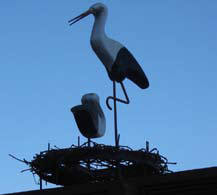
While the Danish have been immigrating to the United States for many years, it was between 1880 and 1920 that as many as 450,000 Danes immigrated to America. In fact, it is said that as many as one in 10 Danes left Denmark, for the most part because of bad economic conditions. When arriving in the United States, they initially settled in the Midwest, particularly in the forests of Wisconsin and Michigan. Later, Danish settlements also began springing up in parts of Illinois, Iowa, Minnesota, Nebraska, Montana, and South and North Dakota. Even today, there are still smaller communities all across the country.
There are as many as 1.5 million Americans who list Danish as their primary or secondary heritage according to the Denmark Tourism Department in New York. However, after moving out of the Midwest, the majority of Danes today make their home in California, followed by areas in Utah and Minnesota.
 One truly authentic Danish town located in California is just a two-hour drive from Los Angeles. Dutifuly staying true to its Danish roots, the town of Solvang, can definitely be said to be all Danish – all the time. It was in this small town that the Danes trace their life in California back to 1911, when a group of Danish-Americans left Iowa to establish a settlement ”out west.” Purchasing from 9,000 to 11,000 acres of land from the Rancho San Carlos de Jonata Mexican Land Grant, the group’s goal was to not only escape the cold Midwestern winters, but also to “preserve and promote Danish culture.” The founders constructed a Danish folk school and church, which is now a Danish restaurant, and they built Atterdag College, which opened in 1914 and closed in 1970.
One truly authentic Danish town located in California is just a two-hour drive from Los Angeles. Dutifuly staying true to its Danish roots, the town of Solvang, can definitely be said to be all Danish – all the time. It was in this small town that the Danes trace their life in California back to 1911, when a group of Danish-Americans left Iowa to establish a settlement ”out west.” Purchasing from 9,000 to 11,000 acres of land from the Rancho San Carlos de Jonata Mexican Land Grant, the group’s goal was to not only escape the cold Midwestern winters, but also to “preserve and promote Danish culture.” The founders constructed a Danish folk school and church, which is now a Danish restaurant, and they built Atterdag College, which opened in 1914 and closed in 1970.
It was not only in Solvang, however, that the Danish communities opened churches and schools, in accordance with the ideas of N. F. S. Grundtvig, a Danish philosopher, hymn-writer and Lutheran pastor. These folk schools, such as the one founded in Solvang, were very important around America, and as such were opened in Elk Horn, Iowa; Ashland, MI; Nysted, NB; Tyler, MN, and Kenmare, ND, each offered a distinct educational approach based on a “spirit of freedom, poetry, and disciplined creativity.”
 As the Danish tradition says, “the presence of a stork on a rooftop wards off lightning and brings good luck.” Even now, in Solvang, the Danish residents really do believe it. In fact, as many as one million visitors come to their town every year.
As the Danish tradition says, “the presence of a stork on a rooftop wards off lightning and brings good luck.” Even now, in Solvang, the Danish residents really do believe it. In fact, as many as one million visitors come to their town every year.
Solvang is also home to a Hans Christian Anderson Museum, the Elverhoj Museum of History and Art, a copy of the famous Little Mermaid statue from Copenhagen, and a replica of the bust of the Danish fairytale writer himself, Hans Christian Andersen. In the city center, there is a 1:3 scale replica of the original Copenhagen observatory Rundetårn, which was completed in 1991.
Celebrating its 100th year anniversary next year, Solvang is a cacophony of Danish sights, sounds, and the true Danish tradition that is unmatched anywhere else in the United States. With a strong Scandinavian culture, it is a European-styled village complete with authentic architecture, thatched roofs and traditional windmills, but there is of course, the flower-lined streets just steps away from the authentic Danish bakeries, restaurants, and shops.

Comments
Response
I think that it is cool for America to have little towns like these. Towns like these make America very unique. In America we have a little bit of every heritage somewhere, and I think that gives Americans an opportunity to experience a lot of different cultures without leaving the U.S.. There's no other place like America because every other country has a majority of just one heritage or culture and the people who live in other countries do not have as good of an opportunity to experience other cultures.